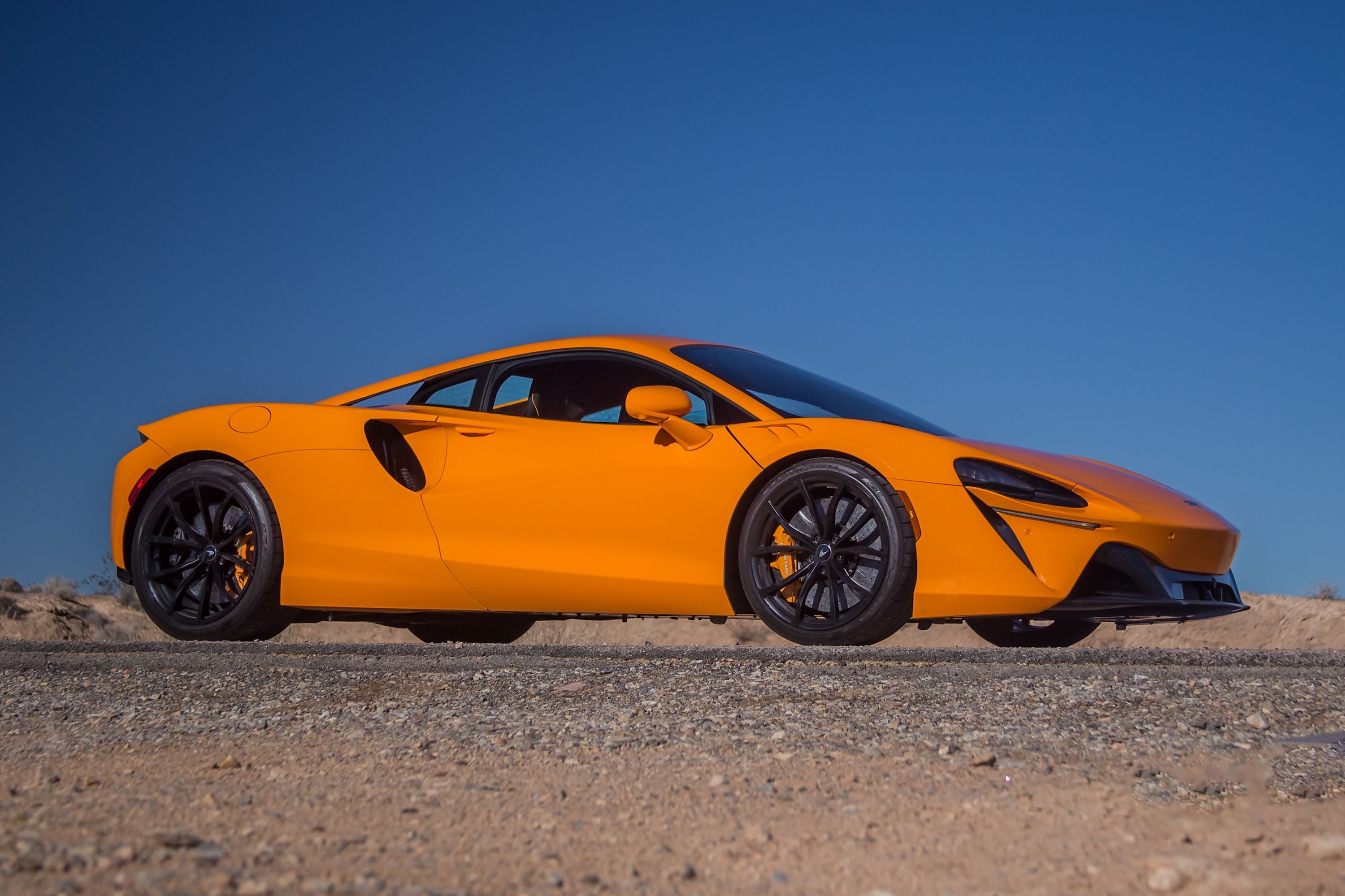
McLaren has a lot riding on its new hybrid supercar. The McLaren Artura is the British company's next generation of series production vehicle and will be the basis of variants for the foreseeable future.
While the Artura is a brilliant all-round and well-balanced supercar, the bests way to think of it here is as a platform. The technology will carry through to future versions, although it may be improved upon as it goes.
There's an insane amount of new technology and clever engineering in the new Artura, so we'll concentrate, for now, on the major areas that come together to make the basis of a platform.
A 120-Degree Twin-Turbocharged V6 Engine
The Artura's powertrain is hybrid, and it's magnificent. It centers around a V6 engine with the banks splayed out at 120 degrees rather than the usual 60 degrees.
The benefits are multiple, ranging from simple to highly technical. The easy-to-explain benefits are that the arrangement lowers the engine's mass in the car, helping its center of gravity. It also gives the two turbochargers somewhere to live in what's known as a "hot V" configuration, which minimizes the amount of plumbing needed. McLaren did something different, though, and faced the turbos to mirror each other, so they're rotating in opposite directions while both feed both banks of cylinders. This minimizes exhaust pressure loss and economizes the amount of plumbing needed for the system.
The engine weighs 353 pounds, much less than McLaren's existing V8. Another benefit is that it's shorter and allows McLaren to reduce the car's wheelbase by 1.2 inches. On top of that, you'll see in the pictures below that the packaging is damn near perfect. The exhaust manifold outlets sit in the bottom corners, the turbos in the V, and the whole assembly is a neat package to slip into the engine bay.
Small But Powerful Axial Flux Electric Motor
The biggest problem with hybrid sports cars is the size and weight of the electric motor being added.
Typically, an electric motor is a large, heavy tube based on a radial flux design, meaning the permanent magnets are mounted on the rotor, and the magnetic field radiates out perpendicular to the axis of rotation. Obviously, right? Well, it gets more complicated as an axial flux motor runs a magnetic field parallel to the rotation axis, essentially using two iron rotor discs, each with permanent magnets, making sure a magnetic north pole is always aligned to a south pole on the opposing disc.
An axial motor is more efficient in using its copper coil and puts the magnets further apart, generating less heat. Because the magnets are further apart, they create more leverage which translates into more torque. That makes an axial flux motor perfect for the application McLaren wants it for - torque fill while the turbos are winding up, resulting in an immediate throttle response.
Its form factor, which you can see below, is small and thin, meaning it can go into the transmission case while weighing just 34 pounds and generating 91 horsepower.
Tri-Clutch Transmission
Using a tri-clutch transmission here is about something other than changing gears faster. It's about getting rid of one.
Two clutches take care of changing ratios in the usual high-performance manner. At the same time, the third disconnects the engine from the transmission and hands power production exclusively over to the electric motor. While in electric mode, the transmission shifts through the gears in case the engine needs to kick in.
The weight saving comes by removing the reverse gear and handing that task over purely to the electric motor. When we spoke to McLaren about this, we were assured the battery is never allowed to get to zero and leave you stuck in a parking spot.
Clean Sheet Carbon Chassis
The McLaren Artura is a clean sheet design, although a quick glance at the chassis wouldn't give that away.
It's known as MCLA, for McLaren Carbon Lightweight Architecture, and the first time McLaren has designed the chassis in-house. It took four years to develop and a $600 million investment in a new facility. The build process is more efficient than the previous series-car chassis, taking just an hour to build, with 70% of the process automated. The platform is put together using around 500 parts built into 72 preforms, which make up the 11 sub-assemblies that go into a multipiece tool that is closed, resin-injected, then cured in a mold.
McLaren tells us the new chassis is stiffer and more robust than the previous monocoque. The battery enclosure is built under the floor and an integral part of the chassis, keeping the additional weight as low as possible. The McLaren Artura weighs 3,303 pounds, just 175 pounds more than the McLaren 720S, despite adding a battery and motor.
There are even slick aero tricks slipped in by carefully chamfered corners on the trailing edge of the front wheel arches to help guide air via the body into intakes.
New Ethernet Architecture
Transmitting information around a car typically means a lot of copper wiring and control modules.
To reduce the weight of the electrical system while speeding up communication between sensors, modules, and components, McLaren developed what it calls the first "zonal domain-based ethernet architecture" in a production car. By using its twisted ethernet system, McLaren claims its reduced the weight of the electrical system by 10%, including needing just four control modules instead of 12. This offsets the added weight of quality-of-life features new to McLaren cars, like radar-enhanced adaptive cruise control and over-the-air software updates.
The cherry on top of the cake is the Pirelli Cyber Tire tire-monitoring technology found on the Artura. A sensor weighing just under ten grams sits on the inside of the tire's tread (Tire Pressure Monitor Sensors [TPMS typically reside in the valves) ]and communicates with the car in as close to real-time as you can get. They can feed information such as tire temperature or the current air pressure and can be adjusted for track pressures without throwing unnecessary pressure warnings.

